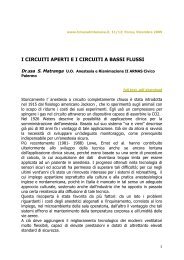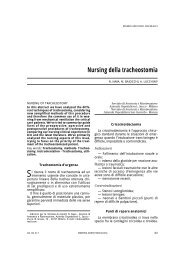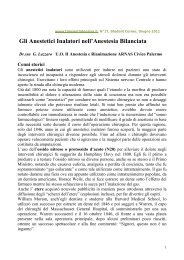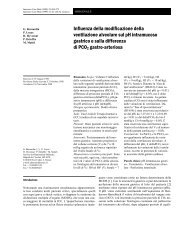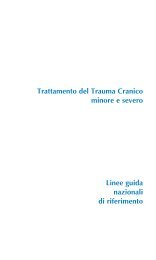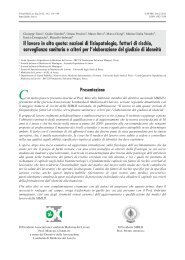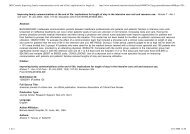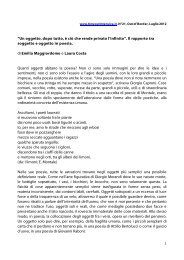a case report - TimeOut intensiva
a case report - TimeOut intensiva
a case report - TimeOut intensiva
Create successful ePaper yourself
Turn your PDF publications into a flip-book with our unique Google optimized e-Paper software.
Cases Journal<br />
BioMed Central<br />
Case Report<br />
Successful management of Influenza A associated fulminant<br />
myocarditis: mobile circulatory support in intensive care unit: a<br />
<strong>case</strong> <strong>report</strong><br />
Ambroise Montcriol* 1 , Sandrine Wiramus 2 , Alberto Ribeiri 3 ,<br />
Nathalie Attard 2 , Lyacine Nait-Saidi 4 , François Kerbaul 1 and Laurent Chiche 2<br />
Open Access<br />
Address: 1 Department of anesthesia and intensive care unit, La Timone Hospital, Saint Pierre street 264, 13885, Marseille, Cedex 5, France,<br />
2Department of anesthesia and intensive care unit, Sainte Marguerite Hospital, Bd sainte Marguerite 270, 13274, Marseille, France, 3 Department<br />
of cardiac surgery, La Timone Hospital, Saint Pierre street 264, 13885, Marseille, Cedex 5, France and 4 Department of cardiology, La Timone<br />
Hospital, Saint Pierre street 264, 13885, Marseille, Cedex 5, France<br />
Email: Ambroise Montcriol* - ambroise.montcriol@free.fr; Sandrine Wiramus - sandrine.wiramus@mail.ap-hm.fr;<br />
Alberto Ribeiri - alberto.ribeiri@mail.ap-hm.fr; Nathalie Attard - nathalie.attard@mail.ap-hm.fr; Lyacine Nait-Saidi - lyacine.naitsaidi@mail.aphm.fr;<br />
François Kerbaul - francois.kerbaul@mail.ap-hm.fr; Laurent Chiche - laurentchiche@mail.ap-hm.fr<br />
* Corresponding author<br />
Published: 18 July 2008<br />
Cases Journal 2008, 1:46 doi:10.1186/1757-1626-1-46<br />
This article is available from: http://www.<strong>case</strong>sjournal.com/content/1/1/46<br />
Received: 24 June 2008<br />
Accepted: 18 July 2008<br />
© 2008 Montcriol et al; licensee BioMed Central Ltd.<br />
This is an Open Access article distributed under the terms of the Creative Commons Attribution License (http://creativecommons.org/licenses/by/2.0),<br />
which permits unrestricted use, distribution, and reproduction in any medium, provided the original work is properly cited.<br />
Abstract<br />
A 26-year-old woman was referred to an Emergency Department because of common flu-like<br />
syndrome with hemodynamic collapse. In Intensive Care Unit (ICU), she was diagnosed as a<br />
probable septic shock. But despite treatment her condition rapidly deteriorated during the<br />
subsequent hours. Diagnosis of cardiogenic shock was established. Mechanical circulatory support<br />
was inserted into the patient. She was transferred in a Cardio-Vascular Surgical ICU where at the<br />
5 th day of mechanical circulatory support, echocardiography showed heart recovery which allowed<br />
weaning of mechanical circulatory support and progressive withdrawal of inotropic support. She<br />
was discharged at the 26 th day. During her hospitalization, presence of Influenza A RNA was shown<br />
in myocardial biopsy.<br />
Introduction<br />
Fulminant myocarditis causing severe hemodynamic dysfunction<br />
and requiring high-dose vasopressors or<br />
mechanical circulatory support is rare; however, intensive<br />
care unit physicians should be aware that its treatment<br />
may require the use of mobile circulatory support devices.<br />
We <strong>report</strong> a <strong>case</strong> of acute fulminant myocarditis caused by<br />
influenza A infection, a rare etiology, successfully treated<br />
by percutaneous extracorporeal membrane oxygenation<br />
(ECMO) with cardio-pulmonary bypass.<br />
Case <strong>report</strong><br />
A previously healthy 26-year-old woman was referred to<br />
the Emergency Department with an influenza-like illness,<br />
which had started 2 days previously, and was associated<br />
with progressive disturbance of consciousness. Clinical<br />
examination was normal except for a blood pressure of<br />
70/30 mmHg and a tachycardia of 120 beats/min. There<br />
was no response to a fluid challenge (1 L of colloid over<br />
30 min). Central nervous system infection was ruled out<br />
by lumbar puncture and cerebral tomodensitometry. Her<br />
white blood cell count was 7,000 per μl and the procalcitonin<br />
concentration was not raised. EKG and chest radiog-<br />
Page 1 of 4<br />
(page number not for citation purposes)
Cases Journal 2008, 1:46<br />
http://www.<strong>case</strong>sjournal.com/content/1/1/46<br />
raphy were normal. The first troponin measurement was<br />
0.02 ng/mL.<br />
The patient was transferred in a medical Intensive Care<br />
Unit (ICU) under the diagnosis of probable septic shock.<br />
Fluid resuscitation (4 L of cristalloids during the 6 first<br />
hours) was followed by a daily continuous infusion of 3 L<br />
of cristalloids and norepinephrine infusion. Antibiotics<br />
were given: cefotaxime (4 × 2 g/day, erythromycin 3 × 1 g/<br />
day and gentamycin 1 × 400 mg/day), plus intravenous<br />
hydrocortisone (200 mg per day).<br />
Fluid resuscitation produced no improvement in blood<br />
pressure. Degradation of the oxygenation (PaO2/FiO2 <<br />
120) requiring mechanical ventilation was observed. Her<br />
hemodynamic status rapidly deteriorated during the subsequent<br />
hours despite high doses of vasopressor (norepinephrine<br />
5 mg/h). Diagnosis of cardiogenic shock was<br />
established by the association of severe hemodynamic<br />
compromise requiring high-dose of vasopressor, low right<br />
atrial oxygen saturation (45%) and transthoracic echocardiography<br />
showing a diffuse hypokinesia with an estimated<br />
left ventricular ejection fraction (LVEF) of 20%,<br />
elevated right and left filling pressures. Left ventricle<br />
diastolic dimensions were however normal (44 mm) as<br />
was septal thickness (8 mm). The troponin I concentration<br />
was 28 ng/mL. Monitoring by pulse contour analysis<br />
and thermodilution showed a cardiac index of 2.4 L/min/<br />
m 2 . Restriction of parenteral fluids and continuous venovenous<br />
hemofiltration with fluid removal at an average<br />
rate of 300 ml/h substantially improved gas exchange.<br />
However, despite increased inotropic support (epinephrine<br />
2 to 25 mg/h and dobutamine 12 μg/kg/min), the<br />
hemodynamic status further worsened and the multiorgan<br />
dysfunction syndrome became obvious (arterial<br />
lactate level at 10 mmol/L, alanine aminotransferase level<br />
of 293 IU/L, aspartate aminotransferase level of 587 IU/L,<br />
bilirubin level of 21 mg/dL and progressive oliguria)<br />
(Table 1).<br />
A circulatory support device was connected by percutaneous<br />
femoral vein and artery cannulation. Pump flow of<br />
3500 rpm generated an output of 4 L/min and a non pulsatile<br />
systemic pressure of 80 mmHg. Intravenous heparin<br />
was given, aiming at an activated cephalin time of 60–80<br />
secs. This procedure allowed rapid weaning of the inotropic<br />
support, and led to urine production and decreased<br />
lactacidemia (Table 1).<br />
The patient was transferred to a Cardiac ICU 24 hours<br />
later. Echocardiography showed lower left and right heart<br />
pressures, but the LVEF was persistently low at 20%. Multiple<br />
biopsies of the myocardium were performed. These<br />
latter, using routine staining, revealed interstitial inflammation<br />
and tissue destruction, but bacterial cultures<br />
remained negative. Real time polymerase chain reaction<br />
Table 1: Evolution of hemodynamic data, inotropic support and biology at the admission and during hospitalization in medical ICU<br />
H H+6 H+12 H+18 H+24 H+48<br />
Emergency<br />
department<br />
ICU admission<br />
ventilation<br />
Before CVVHDF Before ECMO Before transfer in<br />
surgical ICU<br />
Hemodynamic data<br />
MAP (mmHg) 60 66 80 78 55 78 86<br />
Cardiac index (L × min -1 × m -2 ) 4.4 3.8 2.4<br />
LVEF (%) 45 22 11<br />
Urinary output (mL/h) 450 400 33 40 80 100<br />
Inotropic support<br />
Epinephrine (mg/h) 5 25 10 4<br />
Norepinephrine (mg/h) 2.1 4.8 14.4 0<br />
Dobutamine (μg × kg -1 × min -1 ) 8 13 17<br />
Biology<br />
Troponin I (ng/mL) 0.75 10.10 18.6 29.77 28.36 23.18<br />
BNP (pg/mL)) 228 321 288<br />
pH 7.36 7.16 7.27 7.19 7.13 7.30<br />
Lactate level (mmol/L) 0.7 1.25 1.8 2.83 9.84 13.47 11.69<br />
PaO2/FiO2 120 157 59 225 196 312<br />
ASAT (IU/L)/ALAT (IU/L) 43/18 35/21 28/36 587/293<br />
Total bilirubin (mg/dL) 11 15 21<br />
INR 1.33 1.96 2.35 4.15<br />
Factor V (%) 30% < 20%<br />
ICU: intensive care unit; CVVHDF: continuous veno-venous hemodiafiltration; ECMO: extracorporeal membrane oxygenation; MAP: mean arterial<br />
pressure; LVEF: left ventricle ejection fraction; BNP: brain natriuretic peptide; ASAT: aspartate aminotransferase; ALAT: alanine aminotransferase;<br />
INR International Normalized Ratio<br />
Page 2 of 4<br />
(page number not for citation purposes)
Cases Journal 2008, 1:46<br />
http://www.<strong>case</strong>sjournal.com/content/1/1/46<br />
showed the presence of Influenza A RNA in the biopsy.<br />
Influenza A infection was confirmed by serologic tests and<br />
positive culture of the endotracheal aspirate. Liver function<br />
tests improved during circulatory support but there<br />
was anuric renal failure. On the 5 th day of mechanical circulatory<br />
support, echocardiography showed improved<br />
diastolic and systolic function (LVEF of 50%) which<br />
allowed the progressive withdrawal of inotropic support.<br />
Mechanical circulatory support was reduced on the 6 th<br />
day, and was withdrawn 24 hours later. The empiric antibiotherapy<br />
was stopped on the 7 th day; she was extubated<br />
on the 13 th , and vasopressor support was withdrawn on<br />
the 15 th . Renal function recovered after 20 days of continuous<br />
veno-venous hemofiltration. She was discharged on<br />
the 26 th day with an LVEF of 70%, good diastolic function<br />
and no ventricular dilatation.<br />
Discussion<br />
Myocarditis is an inflammation of the myocardium<br />
caused by viral, bacterial or protozoal infections, drug toxicity<br />
or immunological reactions. Viral myocarditis<br />
remains the prototype for the study of this disease and its<br />
evolution. Nevertheless few <strong>case</strong>s of Influenza-associated<br />
myocarditis have been <strong>report</strong>ed [1-6].<br />
The diagnosis of myocarditis may be difficult to make in<br />
the early stages of the disease. In this <strong>case</strong>, it was initially<br />
misdiagnosed as septic shock, in which myocardial dysfunction<br />
and mild troponin increase are commonly seen.<br />
This <strong>case</strong> <strong>report</strong> underlines the role of echocardiography<br />
for diagnosis and management of myocarditis [7]. Left<br />
ventricular dysfunction is the most common abnormality<br />
<strong>report</strong>ed during myocarditis but is unspecific. An increase<br />
in brightness, heterogeneity and contrast of the myocardium<br />
may suggest myocarditis. Furthermore, fulminant<br />
myocarditis could be distinguished from acute myocarditis<br />
by echocardiographic criteria. Patients with fulminant<br />
myocarditis typically have near-normal left ventricle<br />
diastolic dimensions with increased septal thickness at<br />
presentation, whereas those with acute myocarditis have<br />
increased diastolic dimensions but normal septal thickness<br />
[7]. However, in this <strong>case</strong> <strong>report</strong>, septal thickness was<br />
normal. Endomyocardial biopsy is still considered by<br />
many to be the gold standard for diagnosing myocarditis.<br />
Drawbacks are that the results are delayed, and even if<br />
diagnosis is confirmed or an etiologic agent identified, no<br />
specific treatment recommendations for myocarditis can<br />
be made. Indeed, influenza antiviral agents like amantadine,<br />
rimadantine or neuraminidase inhibitors have not<br />
been tested in influenza-associated myocarditis and<br />
immune modulatory therapies have not proved themselves<br />
in controlled trials [8].<br />
The treatment thus remains supportive. Intensive care<br />
physicians suspecting fulminant myocarditis must be prepared<br />
to use therapeutic options such as circulatory support<br />
before severe organ failure develops. Usually heart<br />
transplantation is delayed for weeks. This strategy is<br />
strongly supported by the fact that fulminant myocarditis<br />
are commonly reversible within a few days and have a better<br />
long-term prognosis than acute myocarditis [8].<br />
Circulatory support is used to maintain cardiac output<br />
and organ perfusion, and to minimize the need for inotropic<br />
support until myocardial recovery. Alternatively it<br />
can be a bridge to long-term assist devices or heart transplantation.<br />
We choose a non-pulsatile, servo-regulated<br />
flow system driven by a centrifugal pump with a membrane<br />
oxygenator. It is relatively inexpensive, and can be<br />
set up within 30 min by percutaneous cannulation of the<br />
femoral vessels at the bedside, and can take over the function<br />
of both heart and lungs. Non-pulsatile blood flow is<br />
adequate for short term circulatory support (2–3 weeks)<br />
[9]. Organ dysfunction can be prevented by setting a flow<br />
rate sufficient to normalize indicators of circulatory failure<br />
such as pH, lactate, and SVO 2 [9]. Left ventricular<br />
preload must be optimized and third space fluid reduced<br />
by normalizing oncotic pressure, avoiding excessive volume<br />
loading and using hemofiltration. It is essential to<br />
maintain sinus rhythm and to preserve left ventricular<br />
contractility with inotropic support, to prevent secondary<br />
myocardial damage and thrombotic complication<br />
induced by blood stagnation, even if systemic perfusion is<br />
maintained. Protective mechanical ventilation is maintained<br />
to oxygenate any blood delivered to the pulmonary<br />
vascular bed by residual myocardial activity, and to avoid<br />
atelectasis [10].<br />
Complications associated with these devices are frequent.<br />
Then, even if these devices can be set up in an emergency<br />
unit, their routine management remains the role of specialized<br />
units. Furthermore, the decision to switch to a<br />
pulsatile paracorporeal or implantable systems allowing<br />
extended periods of support, or to proceed with heart<br />
transplantation before complications of long term extracorporeal<br />
circulatory support occur, remains one for experienced<br />
clinicians.<br />
Conclusion<br />
The diagnosis of fulminant myocarditis may be difficult in<br />
the intensive care unit and identification of the viral agent<br />
is uncommon. Echocardiography is invaluable when the<br />
hemodynamic status worsens despite normally adequate<br />
treatment. A human outbreak of avian Influenza A H5N1<br />
could see many <strong>case</strong>s of influenza-associated myocarditis<br />
and thus intensive care unit physicians should be aware of<br />
the possibilities of mobile closed chest cardiopulmonary<br />
bypass.<br />
Page 3 of 4<br />
(page number not for citation purposes)
Cases Journal 2008, 1:46<br />
http://www.<strong>case</strong>sjournal.com/content/1/1/46<br />
Consent<br />
Written informed consent was obtained from the patient<br />
for publication of this <strong>case</strong> <strong>report</strong>. A copy of the written<br />
consent is available for review by the Editor-in-Chief of<br />
this journal.<br />
Competing interests<br />
The authors declare that they have no competing interests.<br />
Authors' contributions<br />
AM, SW and NA wrote the manuscript, LNS performed<br />
echocardiography, AR performed surgical valve replacement,<br />
FK and LC corrected the manuscript. All authors<br />
read and approved the final manuscript.<br />
Acknowledgements<br />
We gratefully acknowledge Pr L. Papazian and Dr C. Guidon for their helpful<br />
collaboration.<br />
References<br />
1. Agnino A, Schena S, Ferlan G, De Luca T, Schinosa L: Left ventricular<br />
pseudoaneurysm after acute influenza A myocardiopericarditis.<br />
J Cardiovasc Surg (Torino) 2002, 43:203-5.<br />
2. Engblom E, Ekfors TO, Meurman OH, Toivanen A, Nikoskelainen J:<br />
Fatal influenza A myocarditis with isolation of virus from the<br />
myocardium. Acta Med Scand 1983, 213:75-8.<br />
3. Letouze N, Jokic M, Maragnes P, Rouleau V, Flais F, Vabret A, Freymuth<br />
F: [Fulminant influenza type A associated myocarditis:<br />
a fatal <strong>case</strong> in an 8 year old child]. Arch Mal Coeur Vaiss 2006,<br />
99:514-6.<br />
4. Nolte KB, Alakija P, Oty G, Shaw MW, Subbarao K, Guarner J, Shieh<br />
WJ, Dawson JE, Morken T, Cox NJ, Zaki SR: Influenza A virus<br />
infection complicated by fatal myocarditis. Am J Forensic Med<br />
Pathol 2000, 21:375-9.<br />
5. Tabbutt S, Leonard M, Godinez RI, Sebert M, Cullen J, Spray TL,<br />
Friedman D: Severe influenza B myocarditis and myositis. Pediatr<br />
Crit Care Med 2004, 5:403-6.<br />
6. McGovern PC, Chambers S, Blumberg EA, Acker MA, Tiwari S,<br />
Taubenberger JK, Carboni A, Twomey C, Loh E: Successful explantation<br />
of a ventricular assist device following fulminant influenza<br />
type A-associated myocarditis. J Heart Lung Transplant<br />
2002, 21:290-3.<br />
7. Felker GM, Boehmer JP, Hruban RH, Hutchins GM, Kasper EK,<br />
Baughman KL, Hare JM: Echocardiographic findings in fulminant<br />
and acute myocarditis. J Am Coll Cardiol 2000, 36:227-32.<br />
8. Magnani JW, Dec GW: Myocarditis: current trends in diagnosis<br />
and treatment. Circulation 2006, 113:876-90.<br />
9. Aoyama N, Izumi T, Hiramori K, Isobe M, Kawana M, Hiroe M, Hishida<br />
H, Kitaura Y, Imaizumi T: National survey of fulminant myocarditis<br />
in Japan: therapeutic guidelines and long-term<br />
prognosis of using percutaneous cardiopulmonary support<br />
for fulminant myocarditis (special <strong>report</strong> from a scientific<br />
committee). Circ J 2002, 66:133-44.<br />
10. Kerbaul F, Collart F, Bonnet M, Villacorta J, Guidon C, Gouin F:<br />
[Perioperative management of ventricular assist devices].<br />
Ann Fr Anesth Reanim 2003, 22:609-28.<br />
Publish with BioMed Central and every<br />
scientist can read your work free of charge<br />
"BioMed Central will be the most significant development for<br />
disseminating the results of biomedical research in our lifetime."<br />
Sir Paul Nurse, Cancer Research UK<br />
Your research papers will be:<br />
available free of charge to the entire biomedical community<br />
peer reviewed and published immediately upon acceptance<br />
cited in PubMed and archived on PubMed Central<br />
yours — you keep the copyright<br />
BioMedcentral<br />
Submit your manuscript here:<br />
http://www.biomedcentral.com/info/publishing_adv.asp<br />
Page 4 of 4<br />
(page number not for citation purposes)




